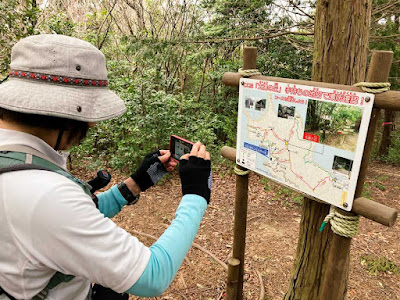 |
| This is the ticket for a date with Deep Time |
Since we have a long drive home, we opt for the varves only – which may be a false economy. For it turns out that both museums owe their existence to the Jomon people who lived beside the lakes from 12,000 to 5,000 years ago. When archaeologists started excavating their trash dump or "midden" of oyster shells in the 1960s, they found that the nearby lakes preserved a particularly fine and deep series of ancient sediments.
 |
| Paying our respects to a reconstructed Jomon dwelling |
Thanks to its sheltered location, and with a bit of help from the local geology, Lake Suigetsu has yielded up one of the world's best series of varves, as such annual markings in the lakebed are known. And, for the trumpery sum of 500 yen each, the Sensei and I are ushered into their presence.
 |
| Vis-a-vis the world's longest unbroken varve series |
During the 1990s, explains our guide, four sediment cores were taken from the bottom of Lake Suigetsu. When these were overlapped to cover gaps, the varves could be traced back for 70,000 years at a stretch, showing more or less one varve for every passing year. This – and surely we detect a note of pride in our guide's voice – represents the longest unbroken series of varves in the world.
We are looking at a wall-mounted display of brownish strips. At first glance, these seem about as exciting as the understated neckties favoured by Japan’s more senior businessmen. Then the guide starts pointing out grey shimmers that cut across the general background of fine-grained stripes. “This one is the Tenshō earthquake in 1586,” he says, referring to a shock so violent that some islands in Ise Bay reportedly sank beneath the waves.
 |
| Signs of a shock that would spoil your day |
Floods and volcanic eruptions too have signed the book of varves. Further along the wall – and so deeper in the stack – is another grey smear. This one, explains the guide, is ash from the Krakatoa-like explosion about 7,300 years ago of Kikai, a volcanic island south of what would one day become Kagoshima. The eruption not only obliterated the island, leaving only a flooded caldera, but it may also have terminated Jomon habitation in Kyūshū. Tephrochronologists love these ash deposits, of course, as they help establish more precise dates for volcanic eruptions.
 |
| Pollen gets in your varves: expanded model of a typical grain |
But there’s more. The Lake Suigetsu record is so long and detailed that, thanks to the organic material such as pollen grains preserved in the mud, it has become a kind of international yardstick for calibrating the carbon dating of archaeological finds. So, by counting up the varves, it is possible to know more exactly, for example, just when the Jomon folk turned their hands to pottery.
 |
| The climate changes before our very eyes |
The Suigetsu yardstick is a long one. It covers the period for which carbon-14 dating can be reliably used - to about 50,000 years ago - and the oldest varves in the continuous series go back to the time when humans first left Africa, driven quite possibly by climate change. Meanwhile, the landscape around the lakes has morphed from a cold, dry steppe into a forest containing beech, oak and walnut trees during the Jomon era, and then again into today's cedar and camellia woods.
 |
| Gazing in the general direction of Deep Time |
Contemplating Deep Time can make the head spin: there is, as a pioneer of the discipline observed no vestige of a beginning, no prospect of an end in the geological record. So, for a breath of fresh air, we walk out onto an outdoors terrace.
A fresh sea breeze ruffles the waters of Lake Mikata, into which the Jomon folk used to toss their discarded oyster shells. Over there, but out of sight behind a low ridge, lies Lake Suigetsu. Under its placid surface, the varves are still piling up at a rate of about two metres per millenium, our guide had said. And I find myself wondering how they will record our Anthropocene Era over the coming centuries ...





















